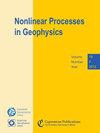On dissipation time scales of the basic second-order moments: the effect on the Energy and Flux-Budget (EFB) turbulence closure for stably stratified turbulence
IF 2.4
4区 地球科学
Q3 GEOSCIENCES, MULTIDISCIPLINARY
引用次数: 0
Abstract
Abstract. The dissipation rates of the basic turbulent second-order moments are the key parameters controlling turbulence energetics and spectra, turbulent fluxes of momentum and heat, and playing a vital role in turbulence modelling. In this paper, we use the results of Direct Numerical Simulations (DNS) to evaluate dissipation rates of the basic turbulent second-order moments and revise the energy and flux-budget turbulence closure model for stably stratified turbulence. We delve into the theoretical implications of this approach and substantiate our closure hypotheses through DNS data. We also show why the concept of down-gradient turbulent transport becomes incomplete when applied to the vertical turbulent flux of potential temperature under very stable stratification. We reveal essential feedback between turbulent kinetic energy, the vertical flux of buoyancy and turbulent potential energy, which is responsible for maintaining shear-produced stably stratified turbulence up to extreme static stability.基本二阶矩的耗散时间尺度:对稳定分层湍流的能量和通量预算(EFB)湍流闭合的影响
摘要基本湍流二阶矩耗散率是控制湍流能谱、湍流动量和热量通量的关键参数,在湍流建模中起着至关重要的作用。本文利用直接数值模拟(DNS)结果评估了基本湍流二阶矩的耗散率,并修正了稳定分层湍流的能量和通量预算湍流闭合模型。我们深入探讨了这种方法的理论意义,并通过 DNS 数据证实了我们的封闭假设。我们还说明了为什么在非常稳定的分层条件下,下梯度湍流输运的概念在应用于潜在温度的垂直湍流通量时会变得不完整。我们揭示了湍动动能、浮力垂直通量和湍动势能之间的基本反馈,它是维持剪切产生的稳定分层湍流直至极端静态稳定的原因。
本文章由计算机程序翻译,如有差异,请以英文原文为准。
求助全文
约1分钟内获得全文
求助全文
来源期刊

Nonlinear Processes in Geophysics
地学-地球化学与地球物理
CiteScore
4.00
自引率
0.00%
发文量
21
审稿时长
6-12 weeks
期刊介绍:
Nonlinear Processes in Geophysics (NPG) is an international, inter-/trans-disciplinary, non-profit journal devoted to breaking the deadlocks often faced by standard approaches in Earth and space sciences. It therefore solicits disruptive and innovative concepts and methodologies, as well as original applications of these to address the ubiquitous complexity in geoscience systems, and in interacting social and biological systems. Such systems are nonlinear, with responses strongly non-proportional to perturbations, and show an associated extreme variability across scales.
 求助内容:
求助内容: 应助结果提醒方式:
应助结果提醒方式:


